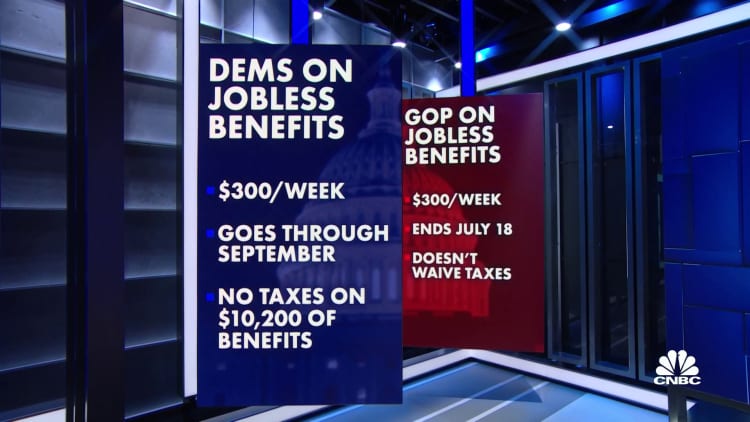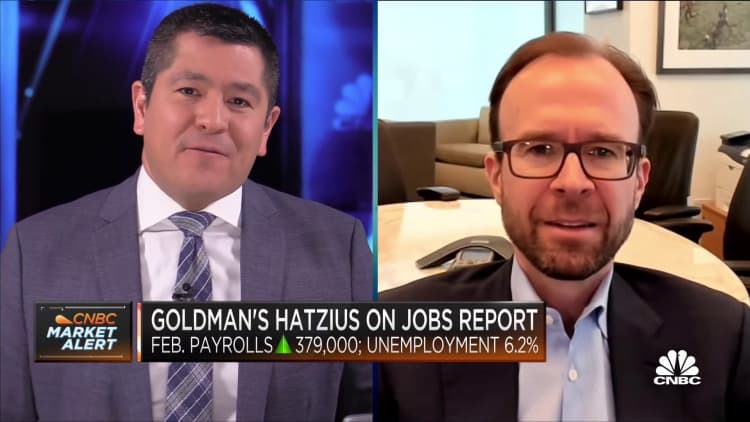Democrats are poised to send more unemployment benefits to laid-off workers. Meanwhile, some workers are still waiting on the last tranche, authorized months ago.
A $900 billion Covid relief bill signed Dec. 27 extended jobless benefits to March 14 and raised them by $300 a week.
In Wisconsin, officials estimate self-employed and gig workers won't get that extra aid until at least April 21 — almost four months later.
Other workers who had exhausted their state benefits just began receiving the extended aid on Thursday, according to Wisconsin's Department of Workforce Development.
Other states, like California and Colorado, only began paying benefits to some groups recently.
Workers who experience delays will get back pay for the missed weeks and be made whole.
But, while they wait for the funds, jobless individuals must go without income support they may need to pay rent or buy food.
'Antiquated'
Wisconsin labor officials blamed outdated technology for the delay.
"DWD is working to implement these new Unemployment Insurance provisions, but our antiquated computer system does not allow all of these programs to be launched at once," according to a state website tracking its implementation progress.
More from Personal Finance:
Smart money moves for student loan borrowers
With 4 million Americans long-term unemployed, benefits cliff looms
1 in 10 Americans say they'll never financially recover from Covid
"Our IT programmers must complete extensive software coding for each program, then deploy them one at a time," it added. "A modernized system would allow for faster, simultaneous implementation of these programs.
The Wisconsin DWD didn't respond to a request for comment.
Clunky technology has plagued many other state labor agencies over the past year as they rushed to dole out funds offered by measures like the CARES Act and Lost Wages Assistance.
Even with modern computer systems, there's typically some lag time.
The U.S. Labor Department must issue guidance to states interpreting the rules contained in a relief law. That sets the parameters for state labor agencies, which then codes the updates into their systems.
There's also typically a period of testing that occurs after programming is complete.

The whole process typically takes about a month, according to Elizabeth Pancotti, a policy advisor at Employ America, a progressive think tank.
Some states have been able to issue aid within days, though.
American Rescue Plan
Delays have been especially pronounced for workers who've collected benefits since the early days of the pandemic — and who exhausted their allotment of aid through two temporary CARES Act programs before the December law extended them.
Those programs are Pandemic Unemployment Assistance, for self-employed, gig, freelance and other workers who don't qualify for state assistance, and Pandemic Emergency Unemployment Compensation, which offers extra state benefits to those who run out of their standard amount.
The Continued Assistance Act extended these programs through March 14.
The $1.9 trillion American Rescue Plan Act of 2021, passed Saturday by the House of Representatives, would extend them through August and raise benefits by $400 a week. Senate Democrats agreed to cut the supplement to $300 a week but extend benefits by another month, through September.
Workers who'd exhausted PUA benefits in Wisconsin appear to be experiencing the longest delays in the country relative to the December law, according to unemployment experts.
California this week just began sending extra aid to workers who had run out of PUA and PEUC benefits, the state Employment Development Department said Thursday.
That affects about 185,000 people, according to the Employment Development Department.
And Colorado did so last week, according to the state's Department of Labor and Employment.
"We know that many Coloradans are facing extreme economic hardships right now, and have been anxiously waiting for the ability to apply for these added benefits," Joe Barela, executive director of the department, said Feb. 7.
A new, modernized cloud-based computer system will allow for "much speedier implementation of future pandemic assistance legislation," Barela said.
The new system, called MyUI+, launched in January.
Mixed Earners

The December law also offered an extra $100 a week to certain self-employed individuals who, due to a quirk in unemployment rules, received a low amount of weekly aid.
Many states haven't rolled out the program, called Mixed Earners Unemployment Compensation, yet. It's a new program created by the December law that requires agencies to vet certain documents to prove a worker's eligibility.
In Virginia, for example, the $100 won't be available until around April 26, according to the state Employment Commission. Wisconsin's target date is April 28. Missouri began offering the supplement on Monday.
Two states — Idaho and South Dakota — opted not to offer it, according to Mixed Earners, an advocacy group.


